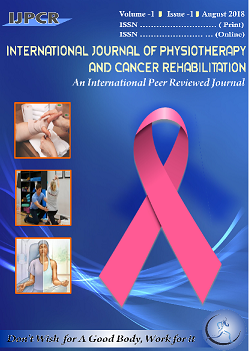International Journal of Physiotherapy and Cancer Rehabilitation
SEARCH
Our Founder
Popurlaly known as ‘jannu bhai’, the Late manishi’s vision, farsightedness and sacrifice have enabled us reach the stature we enjoy today More...Vice Chancellor's Message
It gives me immense pleasure to learn that the 1st volume of international journal of physiotherapy and cancer rehabilitation is being More...Cover Page Volume I Issue I
 .
.
IJPCR
EFFECT OF BMI ON MUSCULOSKELETAL PAIN AMONG TEACHERS OF ABUROAD
1)Dr.Arvind Kumar (PT), 2)Darshana Patel 1Professor & Principal, 2Student 1Ph.D. Scholar, M.PT. (Orthopaedics), M.B.A. (Hospital Management), Dean, Venus Institute of Physiotherapy, Swarrnim Startup & Innovation University, Gandhinagar, Gujarat, India.Email-drarvindmpt@gmail.com, Mob.-9784631151
Abstract:
OBJECTIVE: The objective of the study was to assess the effect of BMI on Musculoskeletal pain among teachers & its prevalence.
METHODS:
All Data were collected by a questionnaire. A questionnaire was distributed to all subjects, total 150 (75 males & 75 females), each subjects were passed to complete the self-administered questionnaire if they fulfil inclusion criteria. A standardized Nordic Musculoskeletal Questionnaire (NMQ general section) was used to collect data on Musculoskeletal symptoms (ache, pain, discomfort) from different regions of the body during last 12 months & the earlier seven days, as well as pain affecting work ability during the past 12 month.This was used as an assessment tool for Musculoskeletal pain in different body region. Also, reliability: 0.61 (Cronbach’s, Alpha validity 0.71) Numerical Pain Rating Scale(NPRS) was used for the perception of pain intensity, which ranges 0-10 is applied,where 0 means no pain & 10 means ‘the worst’’ unbearable pain. Numerical Pain rating Scale was widely used because it is easily administered & requires little to no training or equipment.
RESULTS:
A total 150 teachers (50% male & 50% female) selected in the study.The study showed significant relationship between the BMI & Musculoskeletal pain in mainly low back pain & knee joint, while other region like Neck, shoulder, Elbow, wrist, Upper back, hip & thigh & Ankle & feet did not show significant relationship with score. Since the readings are in nominal scale, to find the relation,chi-square test is used. Any statistical test is said as significant if p-value is <0.05.The most reported musculoskeletal pain level showed prevalent of low back severe pain among teachers, followed by knee pain.
CONCLUSION:
This Study has shown that the most of the teachers were suffering from musculoskeletal pain & significant risk factors, & correlations were observed between BMI & Musculoskeletal pain symptoms in teachers.
Key Words: Work related musculoskeletal pain, Low back pain, WMSDs, BMI, Teachers.